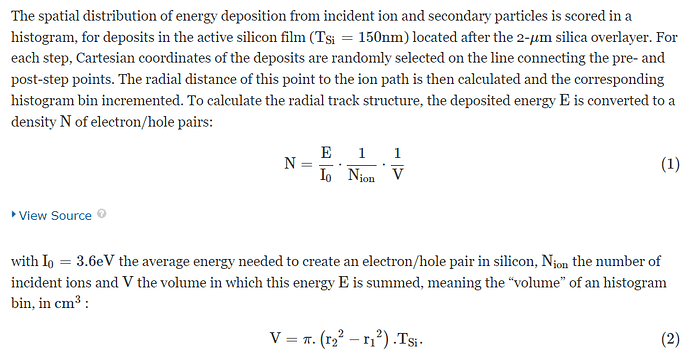Hello,
Is it possible to obtain the above? I am unaware of the underlying physics behind obtaining 1) the stopping energy and 2) electron-hole pair generation, given incident optical photons.
a. I have looked into the extended example OpNovice and OpNovice2 and to the best of my understanding, 1) and 2) can be obtained from secondary particles generated as a result of optical photon interaction with matter. Is this the right idea?
b. In addition, is the following statement accurate: The dominant physics processes that can cause a production of e-h pairs in a material from incident photons are: photoelectric effect and compton effect.
Geant4 doesn’t do electron-hole pairs as such. It’ll produce ionization electrons, if they are above the “production cut” threshold, but won’t treat them like conduction-band electrons, nor will there be any holes propagated.
The G4CMP package is an attempt to support this level of condensed matter physics, but it is very poorly documented (sorry).
Just to be clear, electron-hole pair statistics are not possible for optical photons or in general?
This is because, I have obtained e-h pair stats in Geant4 from incident protons, without the use of any additional package, as outlined in this paper:
M. Raine_Protonsandheavyions_Si.pdf
It uses the methodology in this paper:
Effect_of_the_Ion_Mass_and_Energy_on_the_Response_of_70-nm_SOI_Transistors_to_the_Ion_Deposited_Charge_by_Direct_Ionization.pdf, for the calculationsof e-h pairs using the following formula:
- I had assumed that this is a fairly accurate capture of e-h hole pair stats using. Are there any limitations to such an approach/approximation that I should be aware of?
- Can this formula be used for materials other than Silicon (as long as I in the above formula is changed wrt the particular material’s threshold energy required to generate e-h pairs)?
Ah, I had misunderstood. Yes, that’s perfectly fine for estimating e/h pair statistics. I thought you were interested in tracking the individual conduction electrons and holes “as particles”, which isn’t something Geant4 can do.
You should be able to do what you want, but I think not with “optical photons.” In Geant4, the “opticalphoton” particle type is special – it’s the entity that participates in G4OpBoundaryProcess for reflection, refraction, and so on. My understanding is that “opticalphoton” does not participate in the normal Geant4 electromagnetic processes (ionization, energy loss, etc.).
I think what you would need is to generate G4Gamma (“gamma”) particles, but assign them energy appropriate for an optical photon. We do this in our experiment: we illuminate a silicon sensor with a green (532 nm) laser diode, and measure the energy output with single electron-hole resolution. In the simulation, we use “gammas” with 1.95 eV energy. They have the right penetration depth (~5.3 um), so we get the energy deposit distribution we expect. Then we use the G4CMP package to model the transport, NTL amplification, and energy collection of the conduction electrons, holes, and athermal phonons.
Great, it’s clear. Thank you!
This topic was automatically closed 7 days after the last reply. New replies are no longer allowed.
